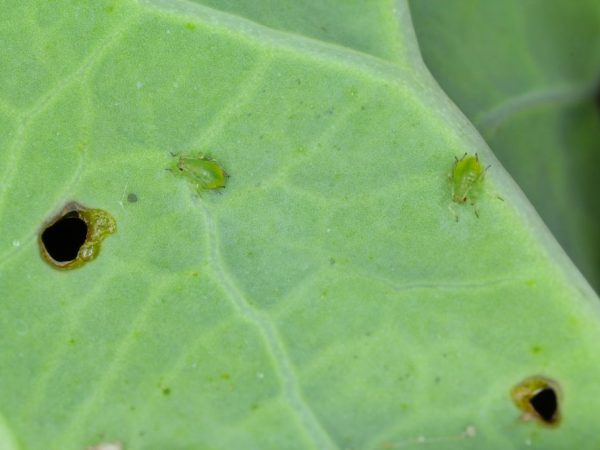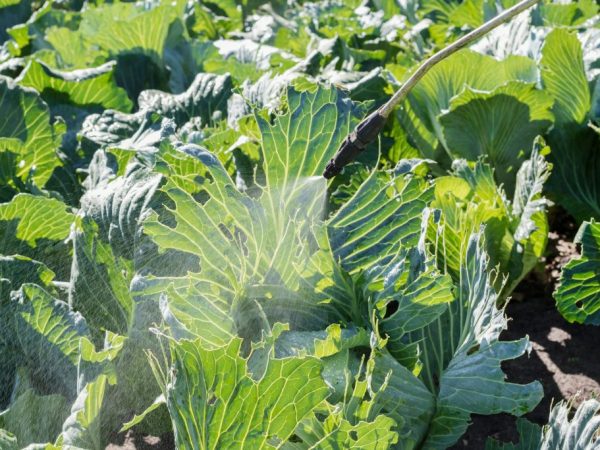Processing cabbage from aphids
One of the most unpleasant pests for the garden is aphids. She especially loves to hit the leaves of young cabbage. These pests multiply quickly and in a short time manage to harm the crop - the processing of cabbage from aphids must be timely.

Processing cabbage from aphids
Pest characteristics
Aphids on cabbage are small insects that reproduce in the fall. The female lays eggs in the weeds, and larvae emerge from them in the spring.
Cabbage aphids differ little from the one that affects fruit trees. This insect is approximately 2.2 mm in size. It has a light green color, its body is covered with a slight coating. The insect has a small trunk, with the help of which it sucks sap from plants.
Reproduction
The pest multiplies quickly, since the birth of offspring takes place without fertilization, and one female lays up to 40 larvae. In one season, up to 20 generations of this pest are replaced. In the spring and summer, only female insects are born. Males are born in the fall, then the females lay eggs that can withstand the winter, and in the spring their life cycle repeats.
Survival features
Another nuance that complicates the process of fighting such a pest is that they can protect themselves from predatory insects. When aphids suck sap from plants, they accumulate glucosinotate in the body. When attacked by a predator, it secretes this enzyme, which turns into a dangerous poison - mustard oil. After that, the attacked insects either die or escape.
Danger of cabbage aphids
Aphids suck sap from the plant. Because of this, the vegetable weakens, metabolic processes are disrupted in it. Aphids can carry about 20 dangerous viruses.
If you do not start the fight against the pest in time, the vegetable will die, the aphid quickly passes from a sick head of cabbage to a healthy one. You need to start fighting aphids on cabbage immediately.
Insects are located on the lower leaves of the cabbage, the plants are carefully examined to detect them. After the defeat of vegetables by aphids, the leaves turn pale and curl up into tubes, their growth slows down. Dark, sticky spots also remain.
Aphid control methods
In one day, aphids affect about 0.1 hectares of the site. To prevent the death of the crop, they begin to control aphids immediately after they have been discovered. The fight against cabbage aphids is carried out using different methods:
- physical;
- chemical;
- biological;
- mechanical;
- folk.
Chemical methods

Preparations help get rid of pests
The chemical method is one of the most common. The “Deltamethrin” cabbage-based aphid remedy is in demand, it contains natural ingredients, so it is safe for humans, but effective in combating such a pest. Insecticidal soap is also used. For the best result, vegetables are treated with a solution of herbal infusions.
You can treat cabbage from aphids with the following drugs:
- "Pyrethrum". This is a powder that is diluted with water in a ratio of 100 g to 15 liters of water.It is better to process in the absence of wind and in dry weather.
- "Karbofos". Take 15 g per 10 liters of water. After treatment with this drug, aphids will not appear during the season, but it is toxic. Plants need to be treated in a protective respirator, gloves, spraying is carried out in calm weather, otherwise the drug can be poisoned.
- "Safe". This drug is not as poisonous as Karbofos. The ratio is 10 g per 10 l, but it is used if the seedlings have not been processed before planting. The effect appears after 2-3 days, the insects disappear.
- "Spark". This insecticide is produced in several versions, it can be the prefix "gold", "bio" or "double effect". It comes in powder, tablet, or liquid form. It is also mixed with water. The drug kills both adult insects and larvae. Its effect lasts up to 20 days.
- Deltamethrin. It is an insecticidal drug that instantly kills pests. On its basis, such preparations as "Atom", "Fas", "Decis Profi" are produced.
Chemical processing is good because it is simple and effective, but it still carries a danger for vegetables, therefore, after processing, natural fertilizers are used.
Physical methods
If there are few insects, this method may work. Its advantage is that it can be fought without the use of chemicals. If there are several aphid insects, they can be crushed right on the plant.
The most effective physical treatment is planting tobacco between cabbage rows. This plant helps to get rid of not only aphids, but also caterpillars and some types of beetles.
Biological and mechanical methods
To get rid of aphids, you can breed some birds and insects, they destroy aphids while still in a larval state. Usually these are tits. To attract them to the site, feeders are installed along its perimeter.
A ladybug helps to get rid of aphids from insects. Specially installed log houses can increase the number of this insect in the garden.
Another chemical-free pest control method is mechanical. When there are few insects, abundant watering helps.
Traditional methods
- A proven popular way to combat aphids is a solution of ash and tobacco. The product is prepared in a ratio of 200 g of each ingredient and 10 liters of water. All components are mixed and insisted for a day, then the cabbage is sprayed.
- Protection from potato or tomato tops is also helpful. 1 kg of raw materials is infused in 10 liters of water. The advantage of folk methods is that they are safe for humans, since almost the entire head of cabbage is eaten and aphids are removed.
- There is a recipe for a solution with yarrow. Take 200 g of leaves, 2 liters of water, leave for an hour and filter. The substance from the onion and its husk is poured with boiling water, insisted and diluted in 10 liters of water. An infusion of celandine also helps; it is effective against cruciferous flea beetles.
- Vinegar is an effective and simple remedy. Its smell repels insects. Dilute 200 ml of vinegar in 5 liters of water and spray the cabbage from all sides.
- Liquid ammonia also helps quickly, it acts on the same principle and even removes adult aphids. For 10 liters of water, take 50 ml of ammonia and pour the cabbage from the watering can. These measures can be applied no more than once every 2 weeks, since a large amount of nitrogen deforms the leaves and disrupts the growth of the vegetable.
- You can use a solution of laundry soap (1 tbsp. L. Diluted in 5 liters of hot water). Heads of cabbage are treated with this agent. It is important to remember that all spraying is carried out in the late afternoon in calm weather.
Prophylaxis
To protect cabbage from aphids, they follow the rules of crop rotation and properly care for the plant. You need to plant a vegetable where beans, carrots or onions grew before. Cabbage aphids can appear with a lack of fertilization of plants, errors of agricultural technology. When the crop is harvested, the remains of tops and weeds are disposed of.
Conclusion
Most often, early varieties of cabbage are affected by cabbage aphids. You can get rid of aphids by applying systematic measures.To keep the crop from attack by insects such as aphids, preventive measures must be taken.


